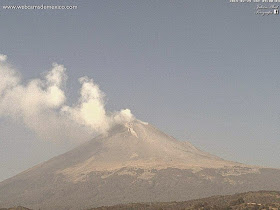Flights from Puebla International Airport in Mexico have been cancelled after an eruption from Mount Popocatépetl covered runways in ash on Tuesday 24 February 2015. The eruption also produced an ash column 4 km high, as well as throwing hot rocks and debris up to 700 m from the crater. Ash drifted to the south and east following the eruption, leading to ashfalls in a number of nearby towns. This is the second time flights from Puebla International have been disrupted by Popocatépetl this year, the first having occurred following an eruption on 15 January. Popocatépetl is one of Mexico's most active volcanoes, having been erupting more-or-less continuously since 1994.
Ash column over Mount Popocatépetl at 9.00 am local time on 25 February 2015, as seen from San Nicolas de los Ranchos, Puebla. Webcams de Mexico.
Volcanic ash is extremely hazardous to aircraft in a number of ways. At its most obvious it is opaque, both visually and to radar. Then it is abrasive, ash particles physically scour aircraft, damaging components and frosting windows. However the ash is most dangerous when it is sucked into jet engines, here the high temperatures can melt the tiny silica particles, forming volcanic glass which then clogs engine. When this happens the only hope the aircraft has is to dive sharply, in the hope that cold air passing through the engine during the descent will cause the glass to shatter, allowing the engine to be restarted.
Major eruptions on Popocatépetl are a cause for concern as the volcano is in a densely populated area, with 30 million people living within the potential hazard zone. The last major eruption, a Plinian (or Vesuvian) event in about 800 AD, triggered a series of pyroclastic flows and lahars that scoured the basins around the volcano.
The location of Popocatépetl. Google Maps.
The volcanoes of the Trans-Mexican Volcanic Belt (including Popocatépetl) are fueled by the subduction of the Cocos Plate beneath the North American Plate along the Middle American Trench to the south of Mexico. As the subducting plate sinks into the Earth it is melted by the heat and pressure, and volatile minerals liquify and rise through the overlying North American Plate as magma, fueling Mexico's volcanoes.
See also...
Mount Popocatépetl in southern Mexico has undergone a series of violent eruptions over the past few days, according to the Centro Nacional de Provención de Desastres, the national agency in Mexico responsible for monitoring volcanic activity. The eruptions...
Fights in and out of Mexico City were cancelled on Thursday and Friday 5 and 6 July 2013, after Mount Popocatépetl, 65 km to the southeast, began a new round of eruptions with an ash column rising...
The central Mexican volcano Popocatépetl began erupting explosively at about 7.30 pm local time on Tuesday 7 May 2013 (12.30 am on Wednesday May GMT), throwing lumps of incandescent rock up to 700 m from the crater and throwing a column of ash 7.6 km...
Follow Sciency Thoughts on Facebook.





